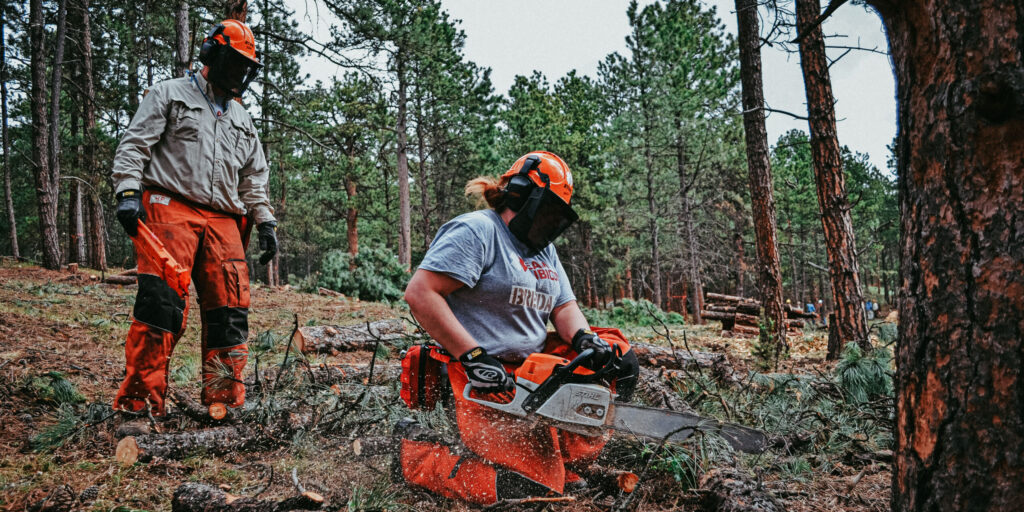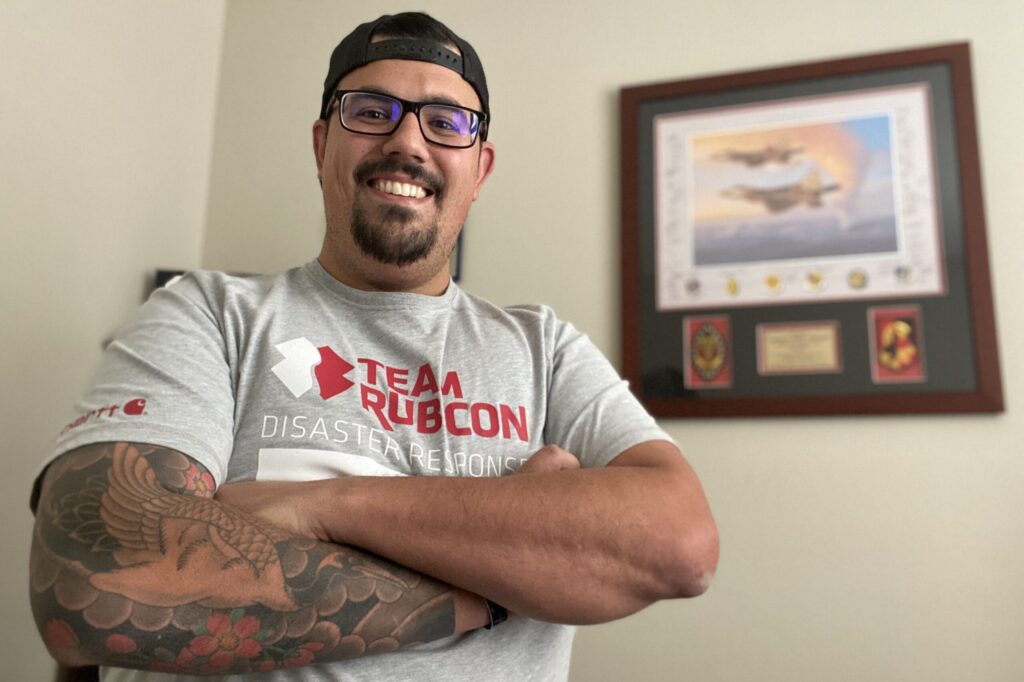Approximately one in four adult Americans have a disability, according to the CDC—more than 61 million people—whether it’s difficulties with hearing, vision, cognition, movement, self-care, or independent living. Globally, the WHO estimates that about 16% of the world’s population lives with a disability—more than 1 billion people. One out of every six humans on the planet experiences significant disability.
The disabled community is possibly the most diverse one in the human experience. In fact, it may be the only demographic that literally everyone could, at some point, join: Anyone can become disabled, at any time, for an unlimited number of reasons. It’s also a story veterans know well: According to the Bureau of Labor Statistics, 30% of U.S. military veterans have a service-related disability—approximately 5.3 million people.
For veteran-led disaster relief nonprofit Team Rubicon, it’s also a reality for many of its volunteers, known as Greyshirts. Whether congenital or acquired during military duty, many Greyshirts are volunteers with disabilities. Yet if living with a disability would seem to some an obstacle to volunteering in a disaster zone, they’d be wrong. Whether they’re bucking and limbing trees downed in a hurricane as sawyers, mucking houses after a flood, tarping roofs after a tornado, or being the force behind the scenes standing up operations and mobilizing others to get in the field, Greyshirts who identify as disabled play critical roles in serving disaster survivors across America and around the world every single day.
Brenda Nurre is one such volunteer. A U.S. Army veteran who became a Greyshirt in 2018, she has served on numerous operations with Team Rubicon. When a rare autoimmune disease cost her her hearing several years back, and masks made it virtually impossible to be in public and lipread during the pandemic, she doubled down and started serving remotely, in roles ranging from communications to mobilization to planning.
“Being able to work remotely made it so that I could still serve and help even if not getting dirty,” says Nurre.

She especially loved mobilization work—getting volunteers where they need to be, assisting with their deployments, and troubleshooting when flights are canceled or schedules change. “I communicate a lot with the Greyshirts. I move them from home to the op and back again and try to do it as nicely as possible.”
Working with the novice volunteers—the first-time Greyshirts, who, she says, typically don’t even know what to pack—is a favorite. “I get to be their personal cheerleader. I like it.”
Not that all of what she does is virtual: Nurre has also returned to the field, where she does everything from recon to sawyer work.
“It’s not hard to work with a disability,” says Nurre. “What’s hard are the stereotypes and biases that others seem to have about people with disabilities.”
Instead of asking a person with a disability what’s wrong, or what they can or can’t do, ask what their strengths are, says Nurre. “Because then, I guarantee if you throw us a problem, we can think outside the box and come up with solutions better than anyone else can,” says Nurre. “We’ve been doing it for ages.”
To Engage More Volunteers With Disabilities, Ditch the Assumptions
Knowing how to treat disaster relief volunteers with disabilities or disaster survivors with disabilities—and not making assumptions—along the way, is also key to success for organizations such as Team Rubicon. That’s because, even if two people appear to share the same condition, those peoples’ requirements and desires may not match, says Kristina Miller, a retired police dispatch supervisor and California Greyshirt.
“Don’t assume because you know one person with a wheelchair, that another wheelchair-user has the same needs and skill sets,” says Miller.

Miller, along with her service dog, Deke, has assisted communities in several states across the country after floods, wildfires, tornadoes, and more. She has served in multiple capacities, from general responder to mission planner to incident commander, and knows the various difficulties Greyshirts, especially volunteers with disabilities, can face in accepting different roles. “Recognize that everybody is an individual, and every disability is unique to the individual.”
And, that there are more people in the world living with disabilities than most know. Disabilities, after all, come in every variety—some are congenital, some are developed from accidents or disease, and some are acquired in combat. And while some are conspicuous, many are invisible.
“The common denominator in disability is the world we live in together,” says Mackenzie Mazen, a senior development associate for Team Rubicon and a Greyshirt who has responded to atmospheric rivers in California and helped communities mitigate wildfire risks. Often the most disabling thing is society, she says. “The biggest thing you notice when you have a disability is that things are inaccessible.”
Task of Revealing Disability Tedious, Yet Essential
For many people with disabilities, access often begins with decisions about whether, or how, to disclose a disability.
“It’s not something I lead with in conversation or when I present myself,” says Air Force veteran and Greyshirt Jaecob Underwood, who regularly deploys as a chainsaw operator, general responder, and incident commander. “But it’s important that people have the space to do so. That they know they can talk about it and it’s safe to do so.”

While dealing with the general public can be challenging, says Miller, it’s easier in the TRibe. “Greyshirts ask; they’re very respectful. It can be a process out in the world, but Team Rubicon volunteers kind of get it, like ‘Deke is your service dog. Ok, cool’,” she says.
Revealing a disability may be slightly easier within Team Rubicon, given that the nonprofit has more experience with volunteers with disabilities than many do: More than 53% of Greyshirts are veterans.
“It’s getting easier to talk about a disability within the veteran community,” says Underwood, citing the shared backgrounds, lessening stigma, and a tendency among veterans to employ dark humor. “The humor, the banter … culturally it’s more commonplace to talk about it.”
Although disability is common, it is still misunderstood and that misunderstanding can leave many feeling excluded.
“People with disabilities are often afraid to admit them because they’re afraid they’ll be left out if they do,” says Nurre.
“I don’t think there’s any disabled person that wouldn’t say it sucks sometimes, or all the time at times, but you kind of just have to talk about it,” says Mazen. “It’s part of your identity and people have to understand: This is part of who I am.”
The communication needs to be two-sided though, the Greyshirts argue.
“People are afraid to ask, people are afraid to reveal,” says Nurre. “We won’t break—and we’re not going to break you, either.”
Being able to reveal the disability is also essential to improving access—not only for yourself but also potentially for others, the disaster response volunteers would argue.
“If you’re a person with a disability, there’s a lot of history out in the world of us struggling to know how much to reveal, explains AM Dillon, a formerly nationally certified EMT for 20 years, certified wilderness EMT, and Greyshirt since 2022 who has served on multiple operations with Team Rubicon. She deployed twice to hurricane-hammered Florida in response to Hurricane Ian—both times in her wheelchair and with her service dog, Lucky. In addition to knowing how much to reveal, there’s the issue of learning to advocate for accommodations.
“Is it okay to ask for assistance for this or that? How do I ask for it? And it took me a while to get there.”
To Break Down Big Barriers, Start With Small Changes
Accessibility does not look the same for everyone, of course, says Dillon, who is also a certified ADA coordinator. And creating an accessible volunteer experience or workplace doesn’t have to be complicated. Inclusion can be as simple as using the same font throughout a document or stating your name out loud every time you speak in an online meeting—significant differences for the visually impaired. Using captions in meetings improves access and inclusion for the hearing impaired, as does offering remote opportunities for those with mobility or other issues.

In the field, securing billeting and Forward Operating Bases at facilities with a 32-inch-wide swinging entrance and ramps that accommodate wheelchairs, and ensuring adequate lighting throughout for those with poor vision makes it easier for everyone to serve on disaster operations.
“It’s about universal access;” says Dillon, “making accommodations, not assumptions, benefits everybody while maximizing access.”
Mazen agrees. “Accommodation means I can participate,” says the development associate and Greyshirt. “You’ll still have medical ailments, chronic illnesses, physical limitations, and all that, but you’re able to participate fully in a way that makes sense to you.”
“Being able to be fully present, bringing my whole self to Team Rubicon and the communities we serve is very important,” says Miller. “And that’s another role that we serve: pointing volunteer leaders or volunteers with disabilities to the right direction; getting them to have that right conversation.”
To that end, Miller, Dillon, Mazen, Nurre, and Underwood are all members of the Greyshirts With Disabilities network group, which is dedicated to having those conversations and providing universal access.
“Anybody’s welcome,” explains Dillon. “If you’re someone that has a disability, visible or invisible, or if you’re someone that wants to support a Greyshirt with a disability, we invite you to attend.” In addition to serving as a sounding board and safe space for other volunteers with disabilities, the group has been working on standardizing things like Team Rubicon’s service dog policy and what recon/advon teams should be looking for for accessible billeting and FOBs. These Greyshirts have their fellow volunteers’ backs: In advocating for those with disabilities, they’re working to ensure that every time Team Rubicon stands up an operation, it also removes barriers to service.
GSD With GSWD
Anyone who wants to join or contribute to the Greyshirts with Disabilities network can start by requesting access to the private Facebook group.



